The NVIDIA GeForce GTX Titan X Review
by Ryan Smith on March 17, 2015 3:00 PM ESTOverclocking
Finally, no review of a GTX Titan card would be complete without a look at overclocking performance.
From a design standpoint, GTX Titan X already ships close to its power limits. NVIDIA’s 250W TDP can only be raised another 10% – to 275W – meaning that in TDP limited scenarios there’s not much headroom to play with. On the other hand with the stock voltage being so low, in clockspeed limited scenarios there’s a lot of room for pushing the performance envelope through overvolting. And neither of these options addresses the most potent aspect of overclocking, which is pushing the entirely clockspeed curve higher at the same voltages by increasing the clockspeed offsets.
GTX 980 ended up being a very capable overclocker, and as we’ll see it’s much the same story for the GTX Titan X.
| GeForce GTX Titan X Overclocking | ||||
| Stock | Overclocked | |||
| Core Clock | 1002MHz | 1202MHz | ||
| Boost Clock | 1076Mhz | 1276MHz | ||
| Max Boost Clock | 1215MHz | 1452MHz | ||
| Memory Clock | 7GHz | 7.8GHz | ||
| Max Voltage | 1.162v | 1.218v | ||
Even when packing 8B transistors into a 601mm2, the GM200 GPU backing the GTX Titan X continues to offer the same kind of excellent overclocking headroom that we’ve come to see from the other Maxwell GPUs. Overall we have been able to increase our GPU clockspeed by 200MHz (20%) and the memory clockspeed by 800MHz (11%). At its peak this leads to the GTX Titan X pushing a maximum boost clock of 1.45GHz, and while TDP restrictions mean it can’t sustain this under most workloads, it’s still an impressive outcome for overclocking such a large GPU.
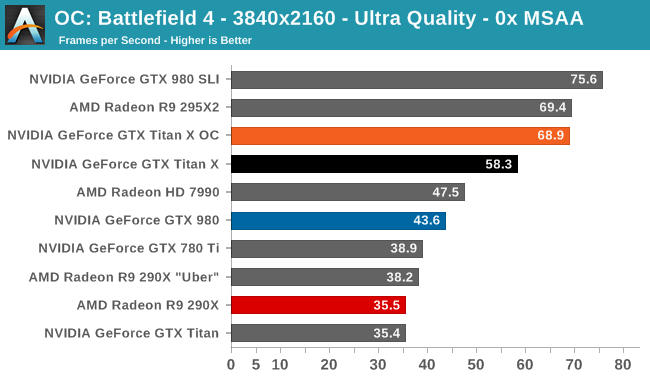
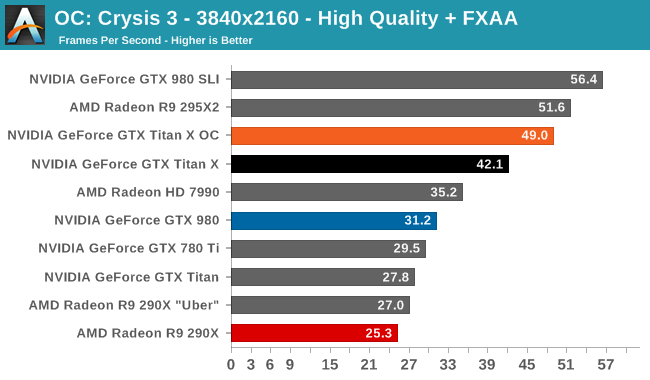
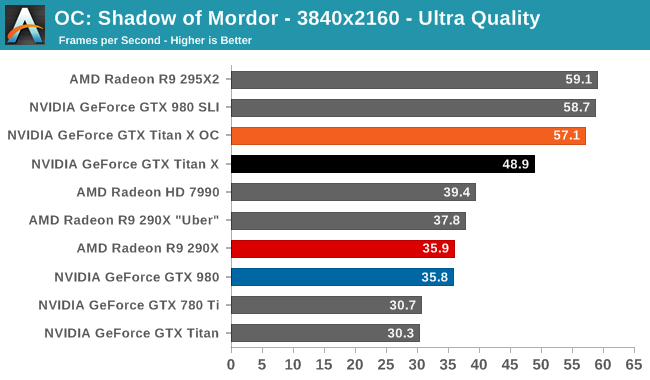
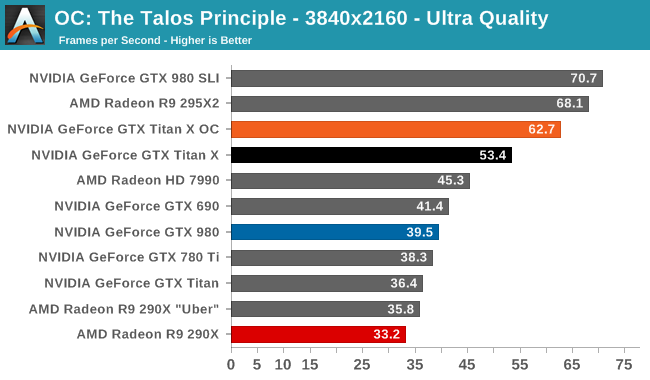
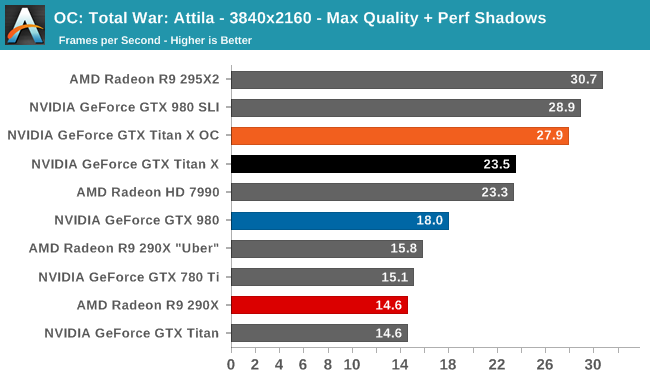
The performance gains from this overclock are a very consistent 16-19% across all 5 of our sample games at 4K, indicating that we're almost entirely GPU-bound as opposed to memory-bound. Though not quite enough to push the GTX Titan X above 60fps in Shadow of Mordor or Crysis 3, this puts it even closer than the GTX Titan X was at stock. Meanwhile we do crack 60fps on Battlefield 4 and The Talos Principle.
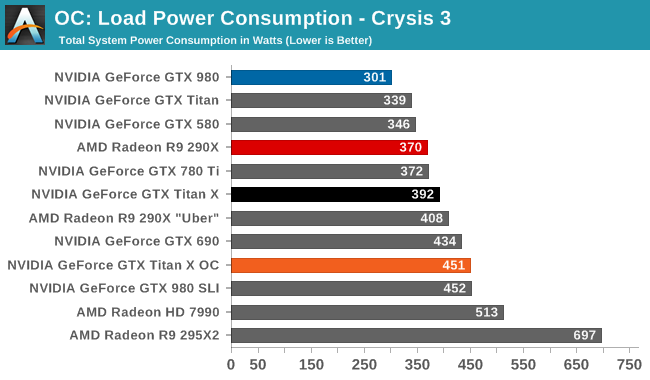
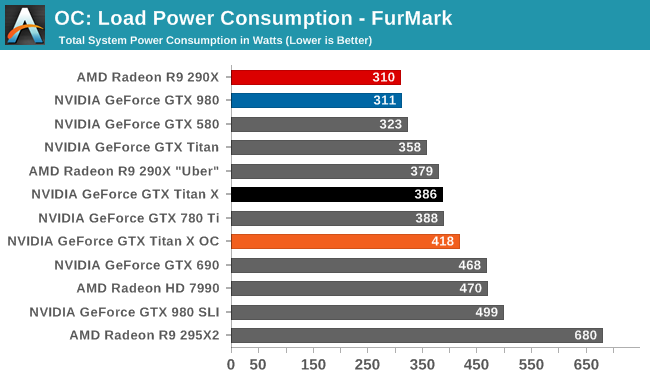
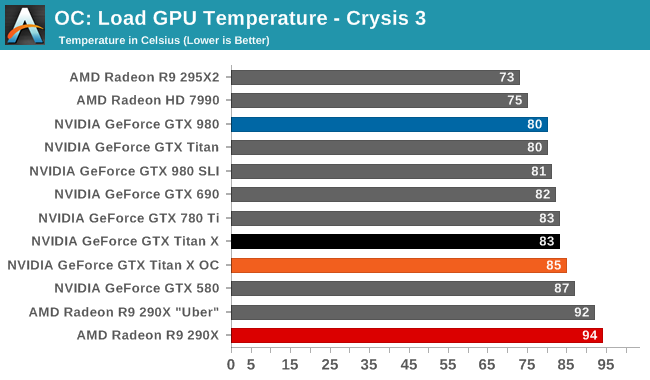
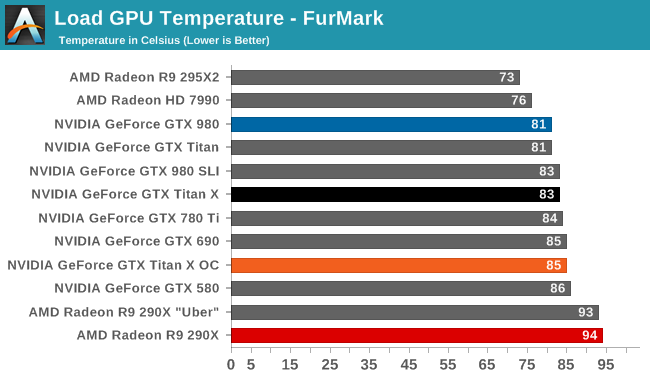


The tradeoff for this overclock is of course power and noise, both of which see significant increases. In fact the jump in power consumption with Crysis is a bit unexpected – further research shows that the GTX Titan X shifts from being temperature limited to TDP limited as a result of our overclocking efforts – while FurMark is in-line with the 25W increase in TDP. The 55dB noise levels that result, though not extreme, also mean that GTX Titan X is drifting farther away from being a quiet card. Ultimately it’s a pretty straightforward tradeoff for a further 16%+ increase in performance, but a tradeoff nonetheless.










276 Comments
View All Comments
Urizane - Monday, March 23, 2015 - link
660 and 660 Ti are different chips entirely, with 660 Ti not fully enabled.chizow - Tuesday, March 17, 2015 - link
@stun you're in for a huge upgrade either way. Makes sense to wait though, but I am not sure if 390X will change current pricing if at all. But Nvidia may also launch a cut down GM200 in that timeframe to give you another option in that $500+ range.Da W - Tuesday, March 17, 2015 - link
Usually, the last one out is the fastest.furthur - Wednesday, March 18, 2015 - link
you're an absolute idiot if you jump on this crap. grab a 290 in the mean time and a 390x on release,Michael Bay - Wednesday, March 18, 2015 - link
Maybe he doesn`t need an equivalent of a room heater in his case like you do, brah.Phartindust - Wednesday, March 18, 2015 - link
At 83c, you're not exactly making ice cubes with titan.cactusdog - Wednesday, March 18, 2015 - link
Im not convinced about this TitanX and the last titan turned out to be a bad investment for the $1,000 asking price. Last time, Titan came out (at $1,000) then a matter of weeks later , the 780TI came out with the same performance for $300 less. This time, we have the 390X soon but no doubt Nvidia have a 980TI up their sleeve, so the value of these highend $1,000 cards disappears quickly making it a bad investment. I expect a $1,000 card to hold the performance crown for at least 6-12 months not a few weeks, then get out performed by a card that costs $300 less.Laststop311 - Wednesday, March 18, 2015 - link
it wasn't weeks later it was many months laterD. Lister - Wednesday, March 18, 2015 - link
@cactusdog"Titan came out (at $1,000) then a matter of weeks later , the 780TI came out with the same performance for $300 less."
Actually the 780Ti, having a lot more CUDA cores, destroys the original Titan in gaming performance. The 780Ti equivalent was the "Titan Black", with the same amount of cores, but twice the VRAM, slightly higher default core clock, and fully unlocked compute.
Phartindust - Wednesday, March 18, 2015 - link
^This